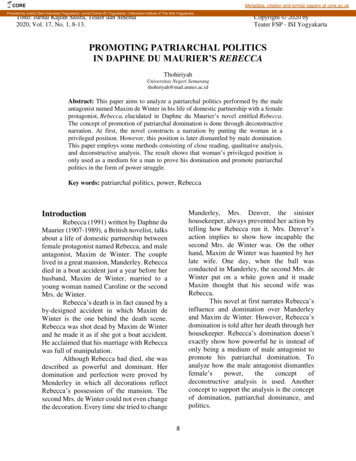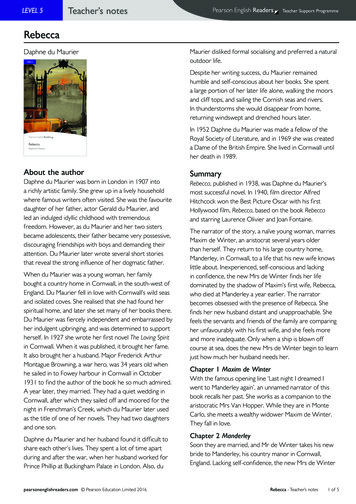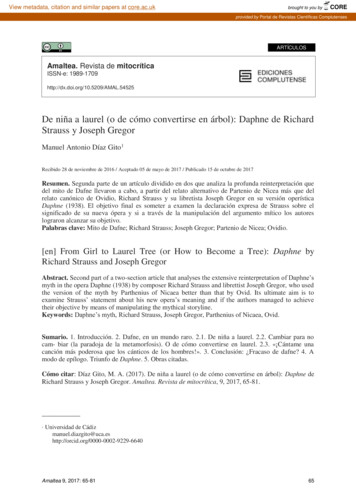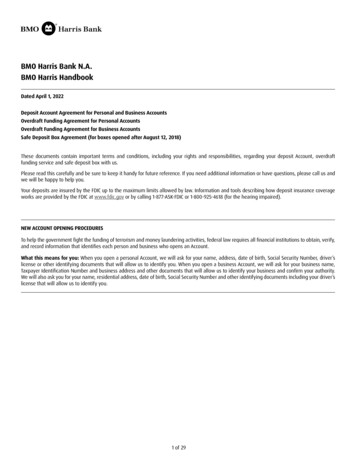
Transcription
A short account of Daphne du Maurier’s life and works 1907-1989Daphne as a young woman at about the time she wrote The Loving SpiritDaphne du Maurier was born on 13th May 1907 at 24 Cumberland Terrace, Regents Park, London.Her father Gerald du Maurier, though largely forgotten now, was in his day a famous actor-manager,who was treated as something of a matinee idol by his adoring audiences. Daphne’s mother MurielBeaumont was an actress, and she and Gerald had met and married while both were acting in theplay The Admirable Crichton, written by J. M. Barrie, himself a hugely successful writer andplaywright and a close friend to several members of the du Maurier family.Daphne was the middle one of three sisters, her older sister Angela also became a writer, and heryounger sister Jeanne was to become an artist. The three girls grew up in the very beautiful CannonHall in Hampstead and enjoyed an idyllic life full of visits to the theatre, to restaurants and onholidays, while home life was a round of parties and huge luncheon gatherings at weekends with thetheatrical celebrities of that era constantly within their sphere. This life suited the outgoing andconfident Angela, and young Jeanne could rely on her Mother to be on hand should she becomeoverwhelmed by all this society. But Daphne was a more solitary girl and found all the constantentertaining too much. She was very much her Father’s favourite daughter, and she spent herchildhood behaving as her Father would want but privately dreaming of other things.The three sisters had a somewhat sporadic education with a variety of schools and governesses. Butthe greatest influence on Daphne was Maud Waddell, always known a Tod, who encouraged thebreadth of Daphne’s reading, really listened to her, understood her and became a lifelong friend,even coming to Daphne’s aid many years later when she needed a governess for her own threechildren at Menabilly.When she was eighteen, Daphne went to a small finishing school at the Villa Camposenea, inMeudon, just outside Paris. Here she quickly found that the way to a more comfortable life was tobe part of the ‘elite’ first class. This group was taught by Yvon Fernande, ate meals at the table withthe Head Mistress and senior staff and enjoyed the seclusion of spending evenings in the‘backroom’, a space reserved for the chosen few to spend time with Mlle Yvon. Much has beenwritten about the relationship which developed between Daphne and Mlle Yvon but suffice to saythat Daphne loved Yvon deeply for a while and spent time with her on holidays in Paris, and other1
parts of Northern France, where Daphne began to write some of her earliest poetry and shortstories.During Daphne’s late teens and very early twenties, she was enthusiastic about her writing but oftendistracted by offers of holidays abroad or family commitments. She loved the fact that hergrandfather, the illustrator and novelist, George du Maurier was half French and, although he haddied before she was born, she enjoyed hearing her father talking about him and other members ofher French ancestry. It is entirely possible that with such a strong family link and the relationshipwith Yvon Fernande she could have made her second home in France and that her writing couldhave taken a very different direction under those influences. However, the turning point came whenher mother decided to take the three girls on an excursion to Cornwall in search of a holiday home.After a false start in Looe, the du Maurier party drove on to Bodinnick to cross the river on the carferry to Fowey. They stopped at the Old Ferry Inn at Bodinnick for lunch and discovered that aformer shipyard, called Swiss Cottage, was up for sale just across the road. Muriel could see thepotential of this property, and it’s beautiful location, just by the ferry slip, nestled beside the RiverFowey, and the girls were all enchanted by the possibilities of holidaying in such a property. Murielhad an eye for creating an attractive home and soon Swiss Cottage had been renamed Ferryside andtransformed into a holiday home for family and friends. When Gerald holidayed at Ferryside plentyof other guests, often from the world of theatre, were invited to help to keep him entertained, butto Daphne’s joy, when the holidays were over, she was often allowed to stay on at Ferryside byherself to pursue her writing. Sometimes she stayed in the house, but often she stayed just acrossthe road with Miss Roberts, a local woman, and let herself into Ferryside each day to sit at her deskand write, in her bedroom overlooking the river.Her early writing often included poetry, possibly as a way of getting ideas down on paper and shecontinued to write short stories. At about this time her Mother’s brother Comyns Beaumont, knownas Uncle Willie, who edited The Bystander magazine, agreed to publish a number of her shortstories, poems and essays, which gave her a feel of what it could be like to earn a living, and a levelof independence, as a writer. She was often called back home to Hampstead to join in familycommitments, and she continued to visit Yvon Fernande in France but would escape back to Foweywhenever she could.Daphne got to know many people in the surrounding area and on the river, and always waved tothe crew of the clay ships as they passed Ferryside on the way to and from the docks. The greatliterary man of Fowey and friend of J.M. Barrie was Sir Arthur Quiller-Couch, also known as Q. Helived with his wife Louisa and their daughter Foy at a house called The Haven on the Esplanade inFowey. Soon Daphne was visiting them regularly for Sunday supper and enjoyed hearing storiesabout the local area and talking about literature and writing with Q. Daphne and Foy became closefriends, a friendship which lasted for their lifetimes.During her early days in Fowey Daphne learned about a mansion called Menabilly, owned by theRashleigh family since Tudor times but now empty because the current owner did not wish to livethere and had allowed the house to fall into disrepair. The house, around the headland fromFowey, but hidden in woodland laid back behind Polridmouth beach, was indeed sad and neglected,as Daphne discovered when she trespassed on the land in an attempt to find the house. She loved iton sight and vowed that one day she would live at Menabilly.One of the people who talked to Daphne and told her lots of interesting facts about the area wasHarry Adams, who taught her how to sail and to fish. He was married to a member of the Sladefamily, who owned the shipyard in the village of Polruan, just downriver. Daphne had found the hulk2
of an old ship called the Jane Slade laid up in Pont Creek with her figurehead still intact. Harry toldDaphne the story of the Slade family and in particular about Jane who was a remarkable womanhaving owned and run the shipyard, following her husband’s death, and at the same time ran one ofthe inns in Polruan. He showed Daphne family letters and papers, and as he did so, the glimmer of anovel began to brew in Daphne’s mind.The novel she wrote was The Loving Spirit (1931), a family saga crossing four generations, based onthe Slade family and the shipyard, with the family in the novel becoming the Coombes. Daphnewrote quickly and then had to edit her work down to a more realistic length, but she was successfulin getting William Heineman to published her, and her first novel sold well.Daphne’s second novel was I’ll Never Be Young Again (1932). She began it once The Loving Spirithad been accepted for publication, but before it had gone into print. She wrote this during a timewhen she was happy to be back at the family home in Hampstead because she had started arelationship with the actor, and later film director, Carol Reed. This relationship seems to have beenher first serious one with a man, and they enjoyed each other’s company spending as much timetogether as possible. This relationship concerned Daphne’s father, but it seems that he wassuffering from jealousy because his dearest daughter was distracted by a handsome young man andhad less time to spend with him. Daphne travelled into London every day to work on her book in aroom that, her father’s secretary and mother’s sister, Aunt Billie loaned her, in Gerald’s offices inOrange Street, off Leicester Square. Daphne wrote quickly and completed the book in two months.I’ll Never Be Young Again was different in style and content to her first book. It was a contemporarynovel, and she drew on her own experiences and observations to write it. It was the first of fivenovels that she wrote in which the narrator, in the first person, was a man, a skill that she used togreat effect. The book tells the story of a young man finding himself and learning aboutrelationships. Its narrative is divided into two distinct parts; the first part is about the young man’spassionate friendship with a man a few years older than himself and the second part is about hislove affair with a young woman.One of the people to read The Loving Spirit was a young army officer called Frederick Browning,known to his family as Tommy and his fellow army officers as Boy. Boy sailed, and he and a friendcame down to Fowey with the specific intention of finding the pretty young woman who has writtensuch a marvellous book.It was to be Boy’s second visit to Fowey before he met Daphne and they became close straight away.Daphne proposed to Boy, and they were married in the tiny church at Lanteglos, close to Ferrysidethree months later. They honeymooned on Boy’s boat Ygdrasil, on the Helford River, and then lifetook a new turn as Daphne began married life as an army officer’s wife.Daphne had always been a fairly solitary girl, happiest with her own thoughts, her writing and theoutdoor life she loved to lead, so marriage and the need to consider her husband and her role as hiswife did not come easily to her. She also soon discovered that her handsome military husbandsuffered from night terrors as a result of the horrors he had encountered in WW1 and was acomplex character, very much in need of her support.The year following their marriage was an eventful one for Daphne, as she struggled to become agood army officer’s wife and her third novel The Progress of Julius (1933), later renamed as Julius,was published. The idea for it formed when Daphne was in Paris in early 1931, and she continued iton her return to Ferryside in March of the same year. The book took nine months to write and wasthe last of her novels to be published by Heinemann. The plot and writing style that Daphne used3
for this book were different again from her first two novels and told the life story of a French Jewishman called Julius Levy. It is a chilling story of a fascinating but intrinsically evil man who achieveswealth and status by using and discarding everyone in his path. Daphne researched the history ofthe 1870 war between France and Prussia and the siege of Paris for the early chapters of the book,but the main relationship between Julius and his daughter was drawn from Daphne's relationshipwith her father.1933 was also the year she gave birth to her first child, a little girl called Tessa. Daphne had beenbought up in a household full of staff, and she too had people to carry out a lot of the work for her.In particular, she always had a nanny for her children and slightly distanced herself from their day today care.The following year brought sadness when Gerald died after a short illness and an operation forcancer from which he never really recovered. Very quickly after his death, Daphne felt that sheneeded to write his biography and set to work straight away. This book, Gerald: A Portrait (1934),was published by Victor Gollancz Ltd, who published all Daphne’s work from then on, and it provedto be a candid view of Gerald’s life. Some of Gerald’s contemporaries were concerned and hopedtheir daughters would not be quite so frank when they died!Daphne’s next novel was Jamaica Inn (1936) most of which was written in Frimley, in Surrey, whereBoy was based. The storyline itself brewed from an outing that had taken place some yearspreviously when Daphne and her friend Foy Quiller-Couch went riding on Bodmin Moor. They werelost in bad weather conditions and sheltered for some time in a derelict cottage on the moor butwere eventually led back to Jamaica Inn by their horses. During that stay at Jamaica Inn Daphne alsomet and talked to the vicar from the nearby church at Altarnun. Jamaica Inn was Daphne’s mostsuccessful novel to date.During 1936 Daphne started work on another biography, this time about her ancestors and calledThe du Mauriers (1937). From the early days of her marriage, she had found her role as the wife of asenior army officer difficult, and the role of wife to the commanding officer even more so. But whenthey were posted to Egypt in 1936, the heat, the different way of life and the responsibility she facedwere very daunting. Daphne travelled to Egypt with little Tessa and her nanny Margaret in March1936, and they moved into a house in Alexandria, which had an excellent housekeeper, who relievedDaphne of all domestic worries.The letters that Daphne wrote to family and friends such as Foy Quiller-Couch indicate how unhappyshe was in Egypt, but to the people that she associated with, during that time, she appeared calmand positive. Everyone knew she was a writer, and this allowed her to be a little separate fromeveryone else. She continued her work on The du Mauriers in the blistering summer heat of Egyptand by the time the book was completed, and on its way back to Victor Gollancz in England, she wasquite unwell. A visit from the doctor confirmed that she was, in fact, not ill but pregnant again.Daphne needed to get away from the heat of Egypt so a holiday in the mountains of Cyprus wasarranged and the family set off in September. Information is a little sketchy as to whether Daphnehad completed The du Mauriers before she went to Cyprus or whether she took her work with herand there is very little mention of Daphne’s time in Cyprus in British biographies. However, it seemslikely that she had completed that book before she went and was beginning to brew the story thatwas to become Rebecca while she was away. Certainly, Rebecca was developed from her longing forEngland and particularly the little part of Cornwall where she was happiest, and her stay in thecooler and more peaceful setting of Cyprus made her feel closer to her life in Cornwall again.4
Daphne and Boy’s entry in the Forest Park Hotel visitors bookThe time in Cyprus was a great success and an idyllic interlude during which time Daphne couldrelax, read, walk and come to terms with her pregnancy, in the cool mountain air. There are severalreferences locally to her visit including an entry in the visitors book at the Forest Park Hotel, in whichDaphne and Boy said they had spent four and a half happy peaceful weeks at the hotel. There is nodoubt that the holiday in Cyprus helped Daphne to cope with the remainder of her time in Egyptuntil she was able to return to England for the birth.Daphne, Tessa and Margaret travelled back to the UK together, but then Daphne went down toFowey alone for a while before returning to London for the birth of her second daughter Flavia. Boyalso had leave due and was able to return to the UK for a few weeks to spend time with family andmeet his new daughter. When they returned to Egypt Daphne and Boy decided that Margaret andthe children should remain in England, with Boy’s sister Grace acting as guardian.Once back in Egypt, Daphne attempted to make serious inroads into her new novel. She said toVictor Gollancz that it was going to be about the influence of a first wife on the second, she is dead before the book opens.Little by little, I want to build up the character of the first in the mind of the second, until wife two ishaunted day and night, a tragedy is looming very close and crash! bang! something happens, it’s nota ghost story.However, things did not go well, and for the first time in her career as a writer, Daphne took the first15,000 words, tore them up and started again, although she hated going over the ground again itwas the only thing to do to get the novel moving in the direction she wanted.Although Daphne wrote part of Rebecca in Egypt, she completed it at Greyfriars, the house theymoved into near Fleet, in Hampshire, near to where Boy had been posted. She sent the manuscriptto Victor Gollancz in April 1938 and Rebecca was published in August. Daphne’s American publisherNelson Doubleday published the US edition in September, and the book took off as a hugelysuccessful novel on both sides of the Atlantic. Daphne was suddenly a big earner and financially verysecure, a fact that Boy accepted with his usual pragmatism as he knew that as a Lieutenant-Colonelin the Grenadier Guards he could never earn the sort of money that his wife could. Boy Browninghad much more worrying things to think about than money, he could see the war clouds gathering5
again, and after his experiences, in the First World War, he was deeply concerned about what wasabout to happen next in the world.Of course, the Second World War did begin within less than a year, and the lives of everyone, notonly the du Maurier Browning family, would never be the same again. Boy became busier andbusier and worked harder and longer hours until he was rarely at home. The decision was made thatDaphne, Margaret, Tessa and Flavia should go and stay as paying guests with a couple called thePuxleys in their beautiful Lutyens house in Hertfordshire. Here they were considered to be safelyaway from London but still close enough for Boy to visit should he have a spare moment.Daphne had become involved with the Moral Re-Armament Group and, through them, made herown small contribution to the war effort by writing a collection of short stories each of which had atheme which would encourage people to be brave and keep going no matter how bad thingsseemed. The stories were published in local newspapers up and down the country and werecollected into a small book called Come Wind, Come Weather (1940), which was sold to raise moneyfor the Soldiers’, Sailors’ and Airmen's Families Association. Editions of the book were sold in severalallied countries including India, Canada and the USA.Christopher Puxley, Daphne’s host, was unable to join up for military service because of healthreasons and he proved to be a charming and relaxed companion, very different to Boy, who was bythen heavily weighed down by the amount of work and responsibility with which he had to cope.Paddy, Christopher’s wife, worked for the Red Cross, the Women’s Voluntary Service, and was alsolooking after two evacuee children. Tessa and Flavia adored her, and everything seemed verycongenial. During her stay with the Puxleys Daphne, who was expecting her third child, moved outfor the birth and then returned when her new little son Christian (known a Kits) was a few weeksold. During this time Daphne was also writing her next novel Frenchman’s Creek (1941).Frenchman’s Creek has been variously described as an adventure story and a romance with a capital“R”. Daphne intended to write something to lighten the mood during the horrors of wartime and tocreate a narrative that was purely escapist and frivolous. She described it as the only romantic storythat she ever wrote, but she was never particularly happy with it. When it was published, it receivednon-committal reviews, and yet, even though initially it lacked the success of Rebecca, it went on tobe one of Daphne du Maurier’s most successful books, probably largely because of its Cornishsetting.Meanwhile, Daphne was developing a romantic attachment for Christopher Puxley, a fact which wasobserved by Margaret, but not initially by Paddy. When Paddy did realise what was going onDaphne, Margaret and the children had to make a hasty exit, and they all fled down to Fowey.Ferryside had become a permanent home for Daphne’s mother and two sisters after Gerald haddied, but it had been seconded by the US Navy, who were in Fowey preparing for D -Day, so the duMaurier family were living temporarily in a house on the Esplanade in Fowey. Daphne rented ahouse at Readymoney Beach just a short walk from her mother’s house and set up home there withMargaret, the children and what-ever other help she could muster.While there Daphne embarked on another novel Hungry Hill (1943), which was a big family saga setin Ireland and based on Christopher Puxley’s copper mining ancestors. She also started to work on aplan to gain agreement from Dr Rashleigh, the owner of Menabilly, to rent the property from him.Amazingly, she gained permission to rent Menabilly, was given a twenty-year lease and managed toemploy people to work on the house and make it habitable. She moved herself, Margaret and thechildren in just before Christmas 1943 and employed several young girls from the local villages tohelp her run this vast house.6
During the time it took to restore the house to a reasonable standard Daphne also wrote a playcalled The Years Between (1945). She had already dramatised Rebecca, which had been a success onthe London stage, and her second play proved to be just as successful. It was the story of the wife ofColonel Wentworth, a Conservative MP, who is reported missing presumed dead during the war. Hiswife goes on to build a life for herself, being appointed MP in his place and finding a new love, onlyto discover, just as the war is ending, that her husband is not dead after all.The first novel that Daphne wrote at Menabilly was The King’s General (1946), a historical novel setduring the English Civil War in the West Country and narrated by Honor Harris, one of Daphne’sbest-drawn female characters. She worked hard on historical research for this book, giving it astrong basis of fact while creating an exciting tale about Richard Grenville, who really was the King’sGeneral in the West, and members of the Rashleigh family living at Menabilly during the time of theCivil War. Daphne dedicated the novel to Boy with the wordsTo My Husband, also a general but, I trust, a more discreet one.After the war Boy worked as Military Secretary at the Ministry of War in London for a short whilebefore being appointed Comptroller and Treasurer to Her Royal Highness Princess Elizabeth and hernew husband Prince Philip. Later, when King George VI died, and Princess Elizabeth became Queen,Boy’s role within the Royal Family changed, and he was appointed Treasurer to the household of theDuke of Edinburgh, with offices in Buckingham Palace. At no time did Daphne seriously consider thepossibility of moving into London to be with Boy, so he stayed in their London flat during the weekand travelled home to Menabilly, by train, on as many weekends as was possible.Meanwhile, problems were brewing for Daphne in the USA. Before the war, there had been someclaim that she had plagiarised Rebecca, but now a court case was pending, and she needed to travelto New York to give evidence. The literary executors of a woman called Edwina MacDonald suedDaphne du Maurier, her US publisher Doubleday Doran & Co. and Selznick International Pictures Inc,who had made the film of Rebecca, starring Lawrence Olivier and Joan Fontaine. They claimed thatthe story of Rebecca had been plagiarised from a short story called I Planned to Murder my Husband,which had later been developed into a novel called Blind Windows. Daphne went through numerousdays of questioning in the New York court, but the case could not be proven, and she was able toreturn home. However, it could not be said that she returned home unscathed because, during hertime in New York, she had stayed with the Doubledays and developed feelings for her publisher’swife, Ellen.Ellen never reciprocated Daphne’s feelings, but they did maintain a long and deep friendship, whichinvolved a vast correspondence over many years, visits to one another and holidays spent together.Once Daphne was back at Menabilly, she wrote the play September Tide (1949), which was basicallyabout her feelings for Ellen, heavily disguised in a relationship between a mother and her son-in-law.The mother figure, Stella, was played by Gertrude Laurence, and the play was another great success.Daphne is seldom thought of as a playwright, but the three plays that she wrote were all West Endsuccesses. Gertrude was another woman that Daphne had strong feelings for, oddly in some waysbecause Daphne’s father had enjoyed a relationship with her when she had been younger.Certainly, Daphne was devastated when Gertrude died after a short illness in 1952 aged only 54.With thoughts of September Tide still in her head, Daphne wrote her next novel The Parasites (1949)about a theatrical family. This book was the first novel that she wrote in her new writing hut in thegrounds of Menabilly, situated a little way from the house and with a view of the Gribbin Daymarkand the sea from the hut’s window. It was also the only novel that she wrote without planning thewhole story into its proposed chapters. The story tells of three adult siblings going back over their7
lives, and each sibling is a different facet of Daphne’s personality. It is a very overlooked novel and isextremely autobiographical, so tells us a lot about Daphne.Daphne’s next project was to edit a book about her grandfather. Her cousin Peter, one of the fiveboys about whom the story of Peter Pan had been written, was a publisher. Daphne and Peterdecided to collaborate on a book based on the letters their grandfather wrote between 1860 and1867, the time when he was a young man establishing himself as an illustrator in London and hisearliest years of marriage to Emma. The resulting book, called The Young George du Maurier: ASelection of his Letters 1860-67, was published in 1951, as was her next novel My Cousin Rachel. Thisbook was another historical novel, based in part at Menabilly and tells the story of a man and hisyoung ward who live in bachelor bliss until the elder of the two becomes ill and needs to travelabroad. While away, he meets and marries a distant cousin called Rachel and subsequently dies.Philip, the young ward, then goes through a range of emotions about Rachel, who eventually comesto live with him on the Cornish estate. The book was written so cleverly that you can never be sureif Rachel is good or evil, and indeed Daphne said that she could not decide the answer to thatquestion either.In 1952 Daphne returned to short stories and published a collection called The Apple Tree, whichincluded The Birds, one of her most famous short stories, because of the Hitchcock film. Her nextnovel was Mary Anne (1954), based on the true story of Daphne’s great, great, great grandmother,who had been a courtesan and who had enjoyed a relationship with the Prince Regent’s brotherFrederick Duke of York.While Daphne had embarked on several relationships, with Christopher Puxley, Ellen and Gertrude,it cannot be entirely surprising that Boy, up there in London working hard, was also coming incontact with people to whom he was attracted. Indeed, when he was back at Menabilly, he had afling with a local girl that he went sailing with and who Daphne, rather cruelly, nicknamed Sixpence,but she was largely oblivious to what was going on. In 1956 Daphne started work on a new novelcalled The Scapegoat (1957). Set mainly in France, this is the story of two men who meet briefly andare identical to one another. A set of circumstances conspire against one of them who then needsto live the other man’s life. It sounds as if readers would need to suspend belief quite substantially,but the novel worked and made a very successful book and film.Sadly, trouble was just around the corner. As Daphne prepared for their 25th wedding anniversaryBoy collapsed in London with a nervous breakdown. The party was cancelled, and Daphne dashedoff to the nursing home in London to see him. Poor, foolish, Boy had been having an affair withSixpence, but also with a woman in London who Daphne called Covent Garden and possibly with oneor two other women. His gilt, the pressure of work, a drinking problem, the exhaustion of travellingfrom London to Cornwall and back week on week and the approaching Silver Wedding hadculminated in a total breakdown. He was a shattered wreck and the sight of him and the gilt thatDaphne also held inside herself almost drove her to a breakdown too. But a determination to getthings right again and to regain each other's trust and love made them both fight to get back to alevel of equilibrium, and to a large extent, they did succeed. Boy had only just gone back to work atBuckingham Palace when Daphne’s mother died, a further blow, which affected her much more thanshe expected it would.Daphne realised that she needed to spend more time in London with Boy and made a huge effort tolive a life that put him first and her writing second. At this time, she wrote a collection of shortstories called The Breaking Point (1959) and felt that they helped her to cope with her feeling ofhopelessness as she literally wrote herself out of her own breaking point.8
The time had come for Boy to retire and move home full time to Menabilly. Daphne could notimagine what life would be like with Boy at home all the time after so many years of leading veryseparate lives. She decided that her next book should be a biography of Branwell Bronte, theoverlooked brother of Charlotte, Emily and Anne. Daphne felt that to carry out research and writebiography rather than more fiction was a more realistic approach for her at a time when Boy stillneeded her support emotionally. During the writing of The Infernal World of Branwell Bronte (1960),Daphne discovered that Winifred Gerin, a recognised biographer, with a book about Anne Brontealready under her belt, was also writing a book about Branwell. Daphne carried on, with greatt
1 A short account of Daphne du Mauriers life and works 1907-1989 Daphne as a young woman at about the time she wrote The Loving Spirit Daphne du Maurier was born on 13th May 1907 at 24 Cumberland Terrace, Regents Park, London. Her father Gerald du Maurier, though largely forgotten now, was in his day a famous actor-manager,










